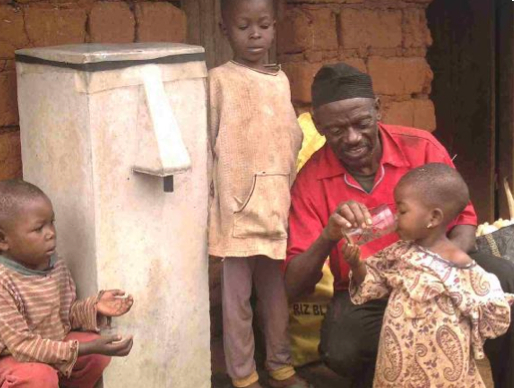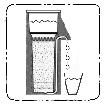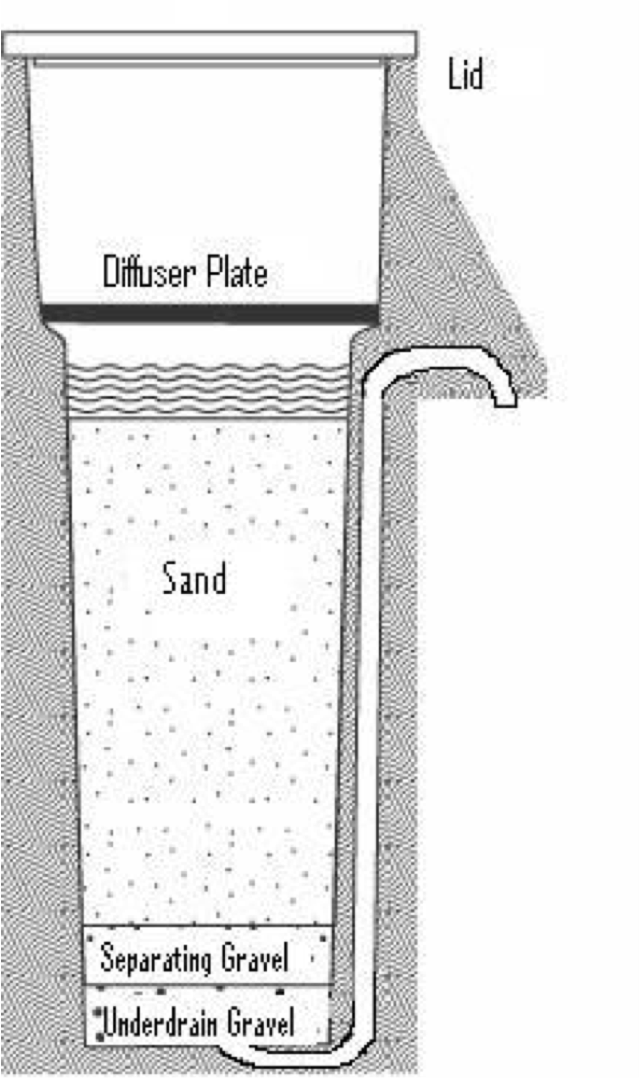Concrete Biosand Filter
| |
|
|
|
|
|
|
|
|
|

The biosand filter (BSF) is an adaptation of the traditional slow sand filter, which has been used for community water treatment for hundreds of years. The BSF is smaller and adapted for intermittent use, making it suitable for households.
Water treatment is carried out by the sand inside the filter. The filter container can be made of concrete, plastic or any other water-proof, rust-proof and non-toxic material, though concrete has several advantages.
Pathogens and suspended material are removed from the water through a combination of biological and physical processes. These occur both in both the biolayer and within the sand bed. These processes include: mechanical trapping, adsorption/attraction, predation and natural death:
- Mechanical trapping: Sediments, cysts and worms are removed from the water by becoming trapped in the spaces between the sand grains. Over time the spaces become smaller, enabling the filter to trap smaller particles sooner in the sand bed. The filter can remove some inorganic compounds and metals if they are attached to other materials or each other.
- Adsorption or attachment: Viruses are adsorbed or become attached to the sand grains. Once attached, they are metabolized by the cells or are inactivated by antiviral chemicals produced by the organisms in the filter. Certain organic compounds are also adsorbed in the sand and thus removed from the water.
- Predation: The microorganisms within the "schmutzdecke" or biological layer consume bacteria and other pathogens found in the water, thereby providing highly effective water treatment.
- Natural death: Food scarcity, less than optimal temperatures and a relatively short life span will cause pathogens to die off and become nutrients for other micro-organisms.
Contents
Suitable conditions
It is suitable to process batches of 12-18 litres. If four batches a day are filtered, this provides 24-72 litres of clean water.
| Advantages | Disadvantages |
|---|---|
| - Removes over 98.5% bacteria, 100% bacteria, turbidity, some iron, manganese, arsenic. Quality of water improves with time. - Cheap, no on-going costs |
- Biological layer takes 3 weeks to develop to maturity - High turbidity (> 100 NTU) will cause filter to clog and require more maintenance |
|
|
Construction, operations and maintenance
The concrete BSF typically uses a box about 0.9 m tall by 0.3 m square, or about 0.3 m in diameter. The filter box is cast from a steel mold or made with pre-fabricated pipe. The container is filled with layers of sieved and washed sand and gravel (also referred to as filter media). There is a standing water height of 5 cm above the sand layer. The different layers trap and eliminate sediments, pathogens and other impurities from the water. Similar to in slow sand filters, a biological layer of microorganisms (also known as the biolayer or schmutzedecke) develops at the sand surface, which contributes to the water treatment. This biological layer matures over one to three weeks, depending on volume of water put through the filter and the amount of nutrients and micro-organisms in the water.
A perforated diffuser plate or basin is used to protect the biolayer from disturbance when water is poured into the filter.
Operation
Contaminated water is poured into the top of the filter on an intermittent basis. The water slowly passes through the diffuser, which dissipates the initial force of the water, and percolates down through the biolayer, sand and gravel. Treated water collects in a pipe at the base of the filter and is propelled through plastic piping encased in the concrete exterior and out of the filter for the user to collect in a safe water container.
The biolayer is the key pathogen removing component of the filter. Without it, the filter is significantly less effective. It may take up to 30 days to establish the biolayer depending on inlet water quality and frequency of use. The water from the filter can be used during the first few weeks while the biolayer is being established, but disinfection is recommended during this time, as during regular on-going use.
The biolayer requires oxygen to survive. When water is flowing through the filter, dissolved oxygen in the water is supplied to the biolayer. During pause times, when the water is not flowing, the oxygen is obtained by diffusion from the air. Correct installation and operation of the biosand filter has a water level of approximately 5 cm above the sand during the pause period. It is this design feature that distinguishes the Biosand filter from other slow sand filters, allowing for small scale construction and intermittent use. The layer of water is shallow enough for oxygen to diffuse through, providing the biological layer with enough oxygen to develop.A water depth of greater than 5 cm results in lower oxygen diffusion to the biolayer. A water depth less than 5 cm may evaporate quickly in hot climates and cause the biolayer to dry out.
A pause period is needed between uses to allow time for the microorganisms in the biolayer to consume pathogens in the water. The recommended pause period is 6 to 12 hours with a minimum of 1 hour and maximum of 48 hours.
The biosand filter has been designed to allow for a filter loading rate (flow rate per square metre of filter area) which has proven to be effective in laboratory and field tests. This filter loading rate has been determined to be not more than 600 litres/hour/square metre.
The maximum recommended flow rate for the concrete biosand filter is 0.6 litres/minute measured when the inlet reservoir is full of water. If the flow rate is much faster, the filter may become less efficient at removing pathogens. If the flow rate is much slower, the user may become impatient and not use the filter even though the filter is working well at removing pathogens. Since the flow rate is controlled by the size of the sand grains, it is very important to select, sieve and wash the sand properly.
The flow rate through the filter will slow down over time as the biolayer develops and sediment is trapped in the upper layer of the sand. For turbidity levels greater than 50 NTU, the water should first be strained through a cloth or sedimented before using the BSF.
The treated water should be collected by the user in a safe storage container placed on a block or stand, so that the container opening is just under the outlet, minimizing the risk for recontamination.
The following should be kept in mind, to ensure correct operation:
- water from the same source is used, regularly
- water supplied from shallow wells and surface waters will develop a faster and stronger biolayer
- water from rain water and deep wells may result in less of a biolayer however the quality from these sources should be better
- water containing VOC’s, insecticides, herbicides, heavy metals, lead, mercury, industrial pollutants, algae, plankton, chlorine and salt should not be used in the filter
- water with a turbidity of less than 100 NTU will still work with more frequently cleaning, water with a turbidity of < 50 NTU is preferred
- maximum flow of 0.6 liters per minute when filter reservoir is full
- pause period
- intermittent cleaning to restore flow rate
- proper “swirl and dump” cleaning process
Treatment Efficiency
Slow sand filters have been proven to almost entirely remove the disease-causing organisms found in water. The Biosand filter adaptation has proven as effective as traditional slow sand filters, in both laboratory and field tests.
In conjunction with the introduction of the technology to communities, the filter has been tested by various government, research, and health institutions, as well as by non-governmental agencies. CAWST carried out water analyses of 107 long term Biosand filter users in Haiti in 2005 and found average removal effectiveness of 98.5% (measuring E. coli, the indicator bacteria recommended by the WHO).
| Bacteria | Viruses | Protozoa | Helminths | Turbidity | Iron | {{{extra_Field}}} | |
|---|---|---|---|---|---|---|---|
| Laboratory | Up to 96.5% 12 | 70 to >99% 3 | >99.9% 4 | up to 100% 5 | 95% up to <1 NTU 1 | Not Available | |
| Field | 87.9-98.5% 67 | not available | not available | Up to 100% 5 | 85% 7 | 90-95% 8 |
The sand selection and preparation are critical to ensure flow rate and effective treatment. The treatment efficiencies provided in the above table require an established biolayer; it takes up to 30 days to establish the biolayer depending on inlet water quality and usage. Removal efficiency and the subsequent effectiveness of the filter increase throughout this period. Although the filter does remove more than 98% of bacteria, below the infectious dose, disinfection is recommended as a final step for households with infants or the elderly.
The filter should be used every day to maintain the biological layer.
The best performance requires a consistent water source; switching sources may decrease treatment efficiency. The swirl and dump maintenance will reduce efficiency until the disturbed biolayer re-establishes itself.
The taste, odour and colour of filtered water is generally improved. The treated water temperature is generally cooler than water stored in a plastic container.
Manufacturing
Local production of filters is most common because materials are readily available all over the world. Molds can be borrowed, rented, bought or constructed locally. Filters can be constructed at a central production facility, or in the community. Filter sand and gravel can be prepared (sieved and washed) on-site or nearby.
Materials required are:
- Steel mold
- Sand, gravel, and cement
- Filter sand and gravel
- Copper or plastic outlet tubing
- Metal or plastic for the diffuser
- Metal or wood for the lid
- Water for concrete mix and to wash filter sand and gravel
- Miscellaneous tools (e.g. wrench, nuts, bolts)
- Facilities: Workshop space for filter construction
A skilled welder required to fabricate molds. Anyone can be trained to construct and install the filter. Individual householders can assist in constructing their own filters.
Working with cement and heavy molds is potentially hazardous and adequate safety precautions should be used. Concrete filters are heavy and difficult to move and transport.
Correct manufacturing and installation, to ensure a long and succesful life, of the biosand filter requires:
- that the box that doesn’t leak
- screened and washed sand, (organic free, Uniformity Coefficient of 1.5 – 3.0 and an Effective size of 0.15 – 0.30 mm - a sieve analysis is required to determine these numbers)
- well washed under-drain and separating gravel
- diffuser plate and lid
- safe storage container
- maximum standing water level of 5 cms
- start-up (maturing) time of 14-21 days
Maintenance
There are no moving or mechanical parts to break. The piping is embedded in concrete, protecting it against breaks and leaks. Cracks can sometimes be repaired.
Concrete filters are heavy (70 – 75 kg for thin wall version and 135 kg for heavy wall version). Poor transportation of filters can lead to cracking and/or breakage. Filters should not be moved after installation.
Maintenance is required when the flow rate drops to a level that is inadequate for the household use. Continued use of the filter causes the pore openings between the sand grains to become clogged with debris. As a result, the flow rate of water through the filter decreases.
To clean the filter, the surface of the sand must be agitated, thereby suspending captured material in the standing layer of water. The dirty water can then be easily removed using a small container. The process can be repeated as many times as necessary to regain the desired flow rate. This procedure is sometimes call a "swirl and dump" maintenance practice. The need to do this depends on the amount and quality of water being put through the filter. If the water is relatively clean (turbidity less than 30 NTU), the filter can likely run for several months without this maintenance procedure. The outlet, lid and diffuser should be cleaned on a regular basis.
The outlet should also be cleaned regularly using soap and water or a chlorine solution.
After cleaning, a re-establishment of the biological layer takes place, quickly returning removal efficiency to its previous level.
Estimated Lifespan
The estimated lifespan is 30+ years; existing filters are still performing satisfactorily after 10+ years. Lids and diffusers may need replacement.
Suppliers
Free mold designs are available from CAWST. A Wood Mold instruction manual is available from the OHORIZONS Foundation.
Costs
| Captial Cost | Operation Cost | Replacement Cost | Estimated 5 years Cost | Cost/liter treated |
|---|---|---|---|---|
| US$ 12-40 = € 8,6 - 28,6 | US$ 0 | US$ 0 | US$ 12-30 | US$ ~0.01 |
Note: Program, transportation and education costs are not included.
Field experiences
In a study in Cambodia, 87.5% of the households surveyed had BSFs in use. Time in use ranged from six months to eight years, and the percentage of BSFs still in use did not decline over the length of time elapsed between BSF installation and follow up. Water, sanitation, hygiene, and other factors were analyzed for association with continued filter use.
Households who reported receiving training in operation and maintenance and those who used deep wells (more than 10 meters deep) were found to be statistically significantly associated with continued BSF use. In BSF households, BSF treatment resulted in a 95% reduction of E. coli and an 82% reduction in turbidity of untreated source water. Furthermore, BSF-usage in households resulted in a 47% reduction of diarrheal disease as compared to control households that did not have BSFs.
However, a significant proportion of BSF-treated and stored samples became re-contaminated after filtration suggesting the need for additional training and education about safe storage and recontamination. Despite recontamination during storage, the concentration of E. coli as well as turbidity were still lower in BSF treated and stored water than in untreated water.
The BSF is a robust water treatment technology for use in rural Cambodian households, capable of effective removal of indicator bacteria, specifically E. coli, and significant reduction of diarrheal disease. BSF performance is comparable to other recommended household water treatment interventions, such as the ceramic water purifier; however BSFs provide the additional advantage of not being prone to breakage or needing replacement parts.
To read the full study: Improving Household Drinking Water Quality: Use of BioSand Filters in Cambodia. Water and Sanitation Program, May 2010.
Akvo RSR Projects
The following project(s) utilize concrete biosand filters.
 Rainwater harvesting for Nicolas School |
Manuals, videos and links
Filter works- Samaritan's Purse CANADA |
filters and health training |
by WOH Meyc |
filter in Lusaka, Zambia |
Mr. Narayan Pandey |
References
- ↑ 1.0 1.1 Buzunis (1995)
- ↑ Baumgartner (2006)
- ↑ Stauber et al. (2006)
- ↑ Palmateer (1997)
- ↑ 5.0 5.1 Not researched. However, helminths are too large to pass between the sand, up to 100% removal efficiency is assumed.
- ↑ Earwaker (2006)
- ↑ 7.0 7.1 Duke & Baker (2005)
- ↑ Ngai et al. (2004)
Acknowledgements
This article is based on a factsheet from Centre for Affordable Water and Sanitation Technology (CAWST), which is gratefully acknowledged.
- Buzunis, B. (1995). Intermittently Operated Slow Sand Filtration: A New Water Treatment Process. Department of Civil Engineering, University of Calgary, Canada.
- Baumgartner, J. (2006). The Effect of User Behavior on the Performance of Two Household Water Filtration Systems. Masters of Science thesis. Department of Population and International Health, Harvard School of Public Health. Boston, Massachusetts, USA.
- Duke, W. and D. Baker (2005). The Use and Performance of the Biosand Filter in the Artibonite Valley of Haiti: A Field Study of 107 Households. University of Victoria, Canada.
- Earwaker, P. (2006). Evaluation of Household BioSand Filters in Ethiopia. Master of Science thesis in Water Management (Community Water Supply). Institute of Water and Environment, Cranfield University, Silsoe, United Kingdom.
- Elliott, M., Stauber, C., Koksal, F., DiGiano, F., and M. Sobsey (2008). Reductions of E. coli, echovirus type 12 and bacteriophages in an intermittently operated 2 household-scale slow sand filter. Water Research, Volume 42, Issues 10-11, May 2008.
- Ngai, T., Murcott, S. and R. Shrestha (2004). Kanchan Arsenic Filter (KAF) – Research and Implementation of an Appropriate Drinking Water Solution for Rural Nepal. [Note: These tests were done on a plastic biosand filter]
- Palmateer, G., Manz, D., Jurkovic, A., McInnis, R., Unger, S., Kwan, K. K. and B. Dudka (1997). Toxicant and Parasite Challenge of Manz Intermittent Slow Sand Filter. Environmental Toxicology, vol. 14, pp. 217- 225.
- Stauber, C., Elliot, M., Koksal, F., Ortiz, G., Liang, K., DiGiano, F., and M. Sobsey (2006). Characterization of the Biosand Filter for E. coli Reductions from Household Drinking Water Under Controlled Laboratory and Field Use Conditions. Water Science and Technology, Vol 54 No 3 pp 1-7.
- Cambodia Country Office. Improving Household Drinking Water Quality: Use of BioSand Filters in Cambodia. Water and Sanitation Program, May 2010.


